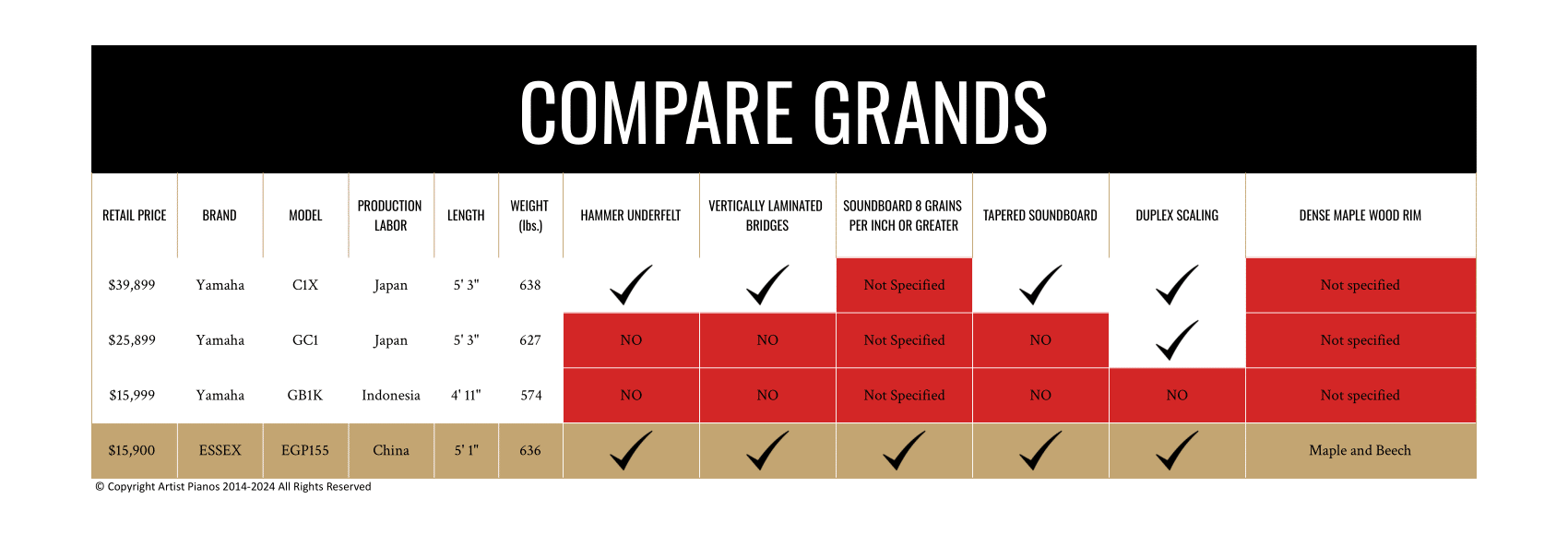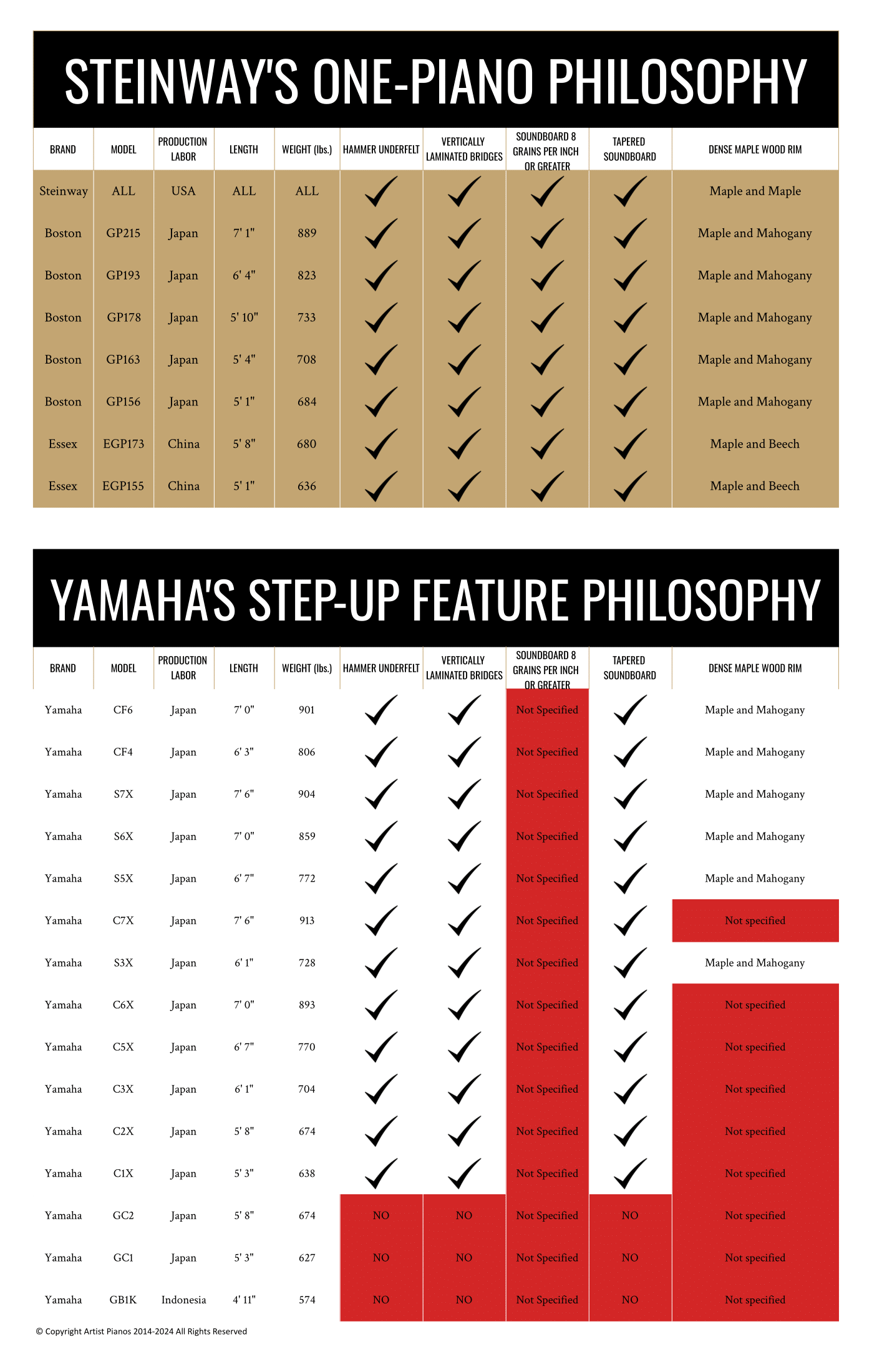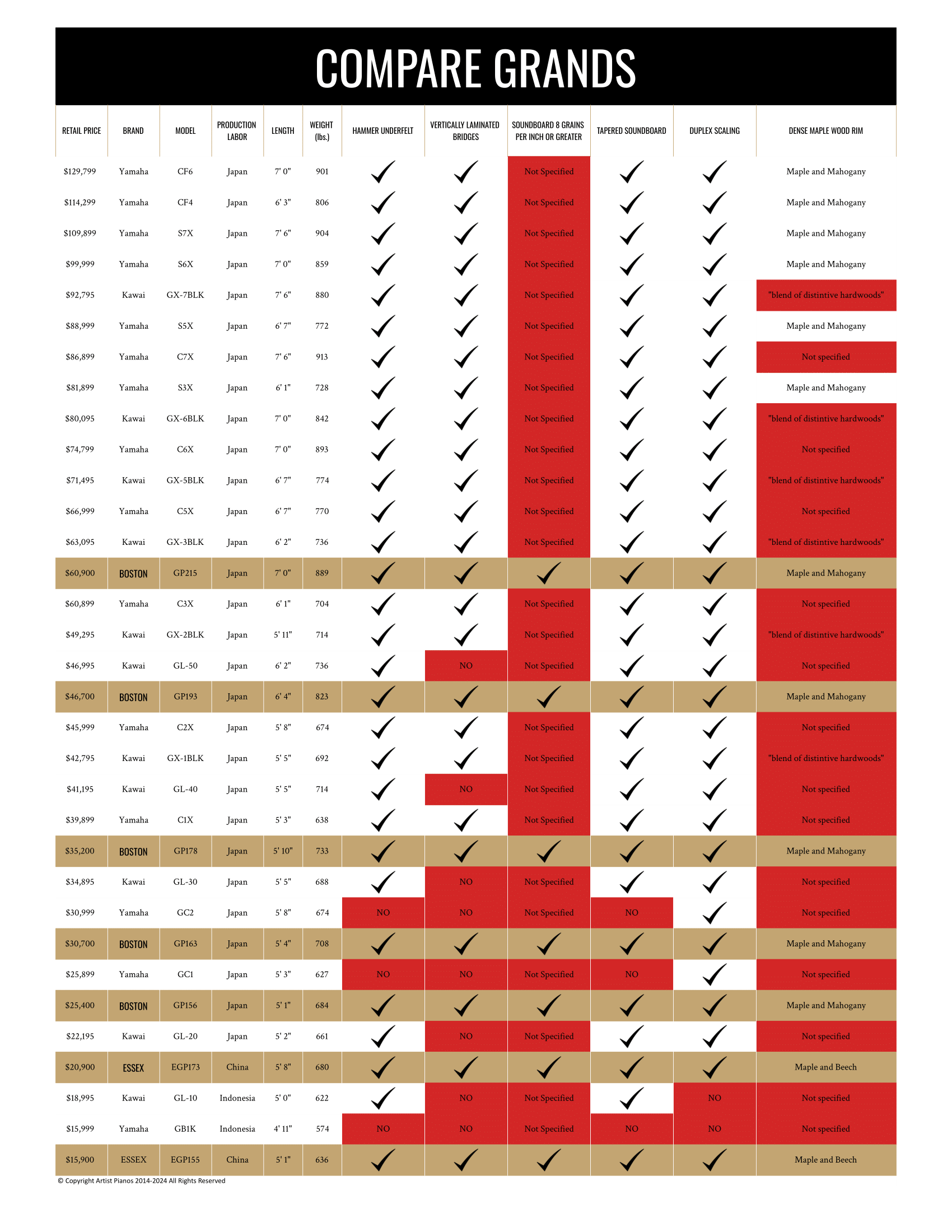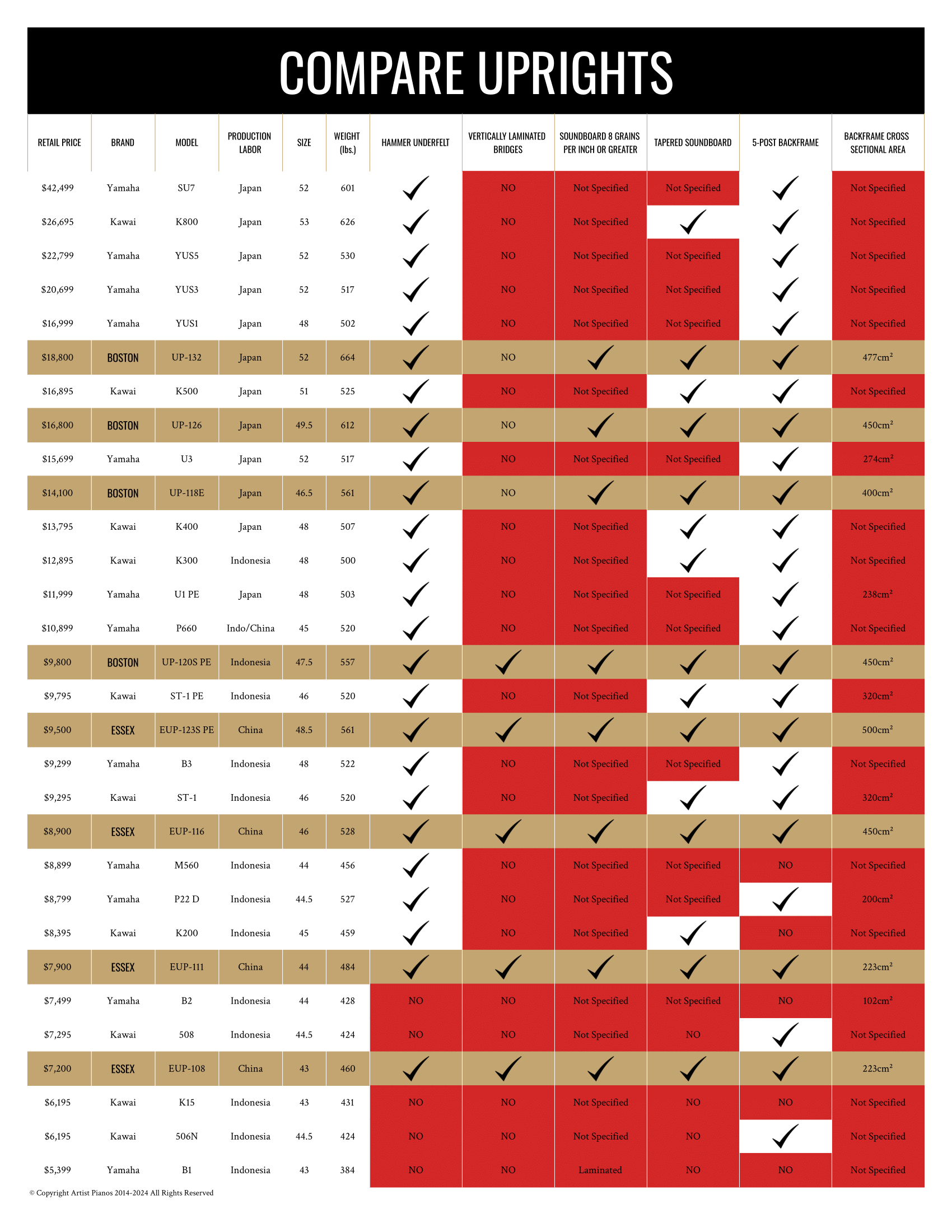


Though it has the second-lowest price on the chart, The Essex EGP-155, by Steinway & Sons has EVERY DESIGN FEATURE AND PREMIUM MATERIAL KNOWN IN THE INDUSTRY TO ENHANCE PERFORMANCE AND LONGEVITY. One has to wonder what justifies the price of the Yamaha C1X? And what, exactly, was changed in the GC1 "M" series and the C1 "X" series besides a higher price and and a letter added to the model number.
The Yamaha GB1K has no premium features. In the Yamaha lineup, you would have to pay thousands of dollars to get duplex scaling on the GC series and then many more thousands to get the additional features of the CX series. In marketing, these are called step-up features. However, Steinway & Sons has a one-piano philosophy, where EVERY BOSTON AND ESSEX IS MADE THE SAME. Core features are never left out to meet a price point.

These are the features consistently found in the best pianos.
Most manufacturers consider them STEP-UP FEATURES to justify spending more money to get them. Breaking from this tradition, Steinway & Sons has designed every affordable ESSEX piano with every feature in every piano.
The comparison charts will make more sense if you read this section.
All the finest pianos have premium solid-spruce soundboards, but spruce soundboards are not created equal. A premium soundboard will be made of straight-grain solid spruce (not laminated) with a minimum of 8 grains per inch and be free of knots and irregularities. These qualities ensure overall structural integrity and even distribution of vibrations. Most manufacturers do not specify anything beyond solid vs. laminated, allowing for a wide variance in wood quality.
To promote flexibility, the soundboard is sanded down to be thinner from treble to bass. Because the board is able to vibrate more freely, bass notes sound richer and fuller and overall tone and dynamic range is improved.
This manufacturer does not publish specifications for the soundboard material for this model beyond the species of wood. Model to model, these soundboards may have variances in grain density, irregularities, knots, or areas where material was cut out and filler material was glued in to take it's place. We inspect the soundboards of every piano we sell and encourage shoppers to inspect the soundboard of any piano they may consider purchasing to determine the quality of the soundboard …more
A one-dimensional soundboard (top) is the same thickness across its width. This piano does not have a tapered soundboard or this manufacturer does not specify whether or not the soundboard is tapered on this model. However, if a piano has a tapered soundboard, it is generally something that a manufacturer would want a shopper to know. All else being equal, a tapered soundboard will provide deeper, richer tone and longer sustain. All Steinway, Boston, and Essex …more
Originally patented by Steinway in 1880, this groundbreaking design is now found in nearly every high-performance piano in production. The solid bridge is replaced with multiple layers of wood, like a layer-cake on its side. This design transfers vibrations from the strings to the soundboard most efficiently and with the least loss of energy. This improves every aspect of tone, projection, sustain, and dynamic range.
Bridges conduct the vibrations from the strings into the soundboard. This piano has bridges made of one piece of wood and may have a maple cap. Most uprights and entry-level grands have one-piece bridges. Nearly all performance grands include vertically laminated bridges to improve tone, sustain, and dynamic range.
Dense under-felt is applied before the white hammer felt is glued and fastened to the hammer molding. This reinforcement will help the hammer retain its shape through years of impact with the strings. Often overlooked and not something that will cause an issue right away, this is a feature many manufacturers will eliminate in order to cut costs.
This manufacturer did not include under-felt on this piano. Instead, the white hammer felt is glued directly to the wooden hammer-head. Under-felt is a layer of very dense felt that is applied first. This helps the hammer take shape at production and retain shape over years of impact with the strings.
With a TOTAL CROSS SECTIONAL AREA of 400cm or more, this piano is built to stand the test of time. The CSA is calculated by multiplying the width and depth of each post by the number of posts and it serves as a measure of the structural integrity of the piano. Like the curved rim of a grand, the back-frame of an upright is responsible for overall structural integrity and maintaining the soundboard crown throughout the years. The stronger the back-frame, the longer …more
If the posts are thick, a 4-post backframe can be solid, but nearly all premium uprights have 5 posts. The back-frame of a piano is responsible in large part for a piano's longevity and performance later in life. Inspect the back-frame of every upright you consider purchasing, because the thickness of the back-posts will be one of the first indicators of an upright piano’s quality.
The rim of a grand piano is primarily responsible for maintaining the crown, or curvature, of the soundboard. This curvature is absolutely critical to a piano's ability to project sound and maintain a tuning to proper pitch. As such, strong, rigid, dense wood makes for solid rim construction. Steinway pianos have a unique one-piece, continuous bent, hard-rock MAPLE rim, Boston pianos have a hard-rock MAPLE inner rim and the outer rim …more
Some manufacturers often use terms like "select hardwoods" and "carefully selected wood based on its acoustic characteristics" to describe their materials. Most often in the piano industry, this can be interpreted as "may change without notice." This manufacturer either does not provide specifications for rim material, uses non-specific terms to describe rim materials, or, in the case of some older pianos, the information was not able to be …more
Originally patented by Steinway in 1872, similar designs are now implemented in countless performance grands. Each treble string is sectioned into three separate vibrating lengths. The longest is in the middle and this is the main note we hear. The duplex sections on either end are tuned to upper harmonics of the main note. This design greatly enhances the complexity and richness of the tone and increases the strength of the very highest notes.
This manufacturer did include duplex scale design on this model. Instead, felt (red in this example picture) is used to prevent the length of string that extends beyond the bridge from vibrating. Duplex scale-design is used to improve the complexity and harmonic content of a piano's tone.

Every Boston & Essex grand has every premium feature. Competitor's pianos do not.
Let's take a look at the Boston GP-215 and compare it to the Yamaha S6X. This is the first model in the Yamaha lineup that has a MAPLE RIM. Why is it priced almost 40% higher? Take a look at the weight of these two pianos: THE BOSTON IS 30 LBS HEAVIER. More weight means more material and denser material. So what is in the Yamaha that justifies this price? Nothing we can find and nothing over 200 ALL STEINWAY SCHOOLS, that use Boston pianos exclusively in their practice rooms, can find either.
The Yamaha GB1K has none of the premium features found in the higher-priced Yamaha grands, yet the ESSEX EGP-155 has ALL of them!
At nearly 3X the price, the Yamaha C1X almost delivers all the premium features, but why is soundboard quality and rim material left unspecified? The rim material on the SX series pianos is specified (it ought to be, for the price), which seems to acknowledge maple as a superior wood for rim construction, but rim material is not specified for any other pianos.
As experts in the field, we cannot imagine the difficulty a shopper might have in trying to compare pianos with Steinway's competitors leaving so many major components unspecified. But this chart shows clearly the components left out altogether.

"So when a piano ad touts a "hardwood rim," or a rim made from "select hardwoods," chances are that the woods involved are not very hard at all; if they were, the ad would likely name the actual species of wood instead of hiding behind such general and potentially deceptive terms."
At one time, we were able to verify that Yamaha used Roslau strings in the YUS5, so we put it on our chart, because it was another example of Essex and Boston materials being used in Yamaha higher end pianos, but not in the more affordable pianos. At our last update, we can no longer find any reference to Roslau strings anywhere on Yamaha's websites, so we have taken down this comparison. However, since Steinway and Boston use Mapes Strings and Essex uses Roslau, we've left the descriptions below:
Stahl- and Drahtwerk Röslau GmbH is a German manufacturer of some of the finest piano wire in the world. Known for its consistency and rich tone, it is found in many high performance pianos...including Essex, by Steinway & Sons.
Known for their "singing tone" and made right here in the USA, Mapes strings have been found on Steinway & Sons pianos for over a century. A fourth generation company, Mapes holds the first patent for a string winding machine.

Even the most affordable Essex upright has every single premium design feature.
At nearly 2X the price of the Essex EUP-123S the Yamaha U1 is one inch shorter and has HALF THE BACKFRAME cross sectional area (CSA). At the same price, Yamaha's P22 is 4" shorter! Is it any wonder schools are switching to Essex? We came to the conclusion that Steinway simply delivers a better value with the Essex brand pianos.
The Yamaha B2 is certainly affordable, but has 25% of the backframe CSA of the Essex EUP116 and NONE of the premium features!
A 5-post backframe is the first indicator that a manufacturer has taken the design of a piano seriously. However, the thickness of the individual back posts matters. A cross sectional surface area of 400cm or more provides massive support year after year for the the soundboard's crown and the nearly 40,000lbs of tension from the strings. The CSA is calculated by multiplying the width and depth of a post, times the number of posts, and it is a good indicator of an upright piano's structural integrity. The cheapest pianos will have very small backposts or no center backposts at all.
Roslau strings? Only found on the most expensive Yamaha available, the YUS5. Why would you have to spend over 3X the price of an Essex to get the best strings?
For various reasons, opinion posts on the Internet (some of them over 20 years old) ignore all measures of quality and summarily put down all pianos made in China.
We will be the first to agree that the finest pianos in the world are made right here in New York at the Steinway factory. We never talk anyone out of getting an American-made Steinway or a Japanese-made Boston. If you like those pianos and they fit your budget, you should absolutely get one. However, a large percentage of our customers are first-time buyers and are shopping for pianos in the Essex price range. We could probably add the Korean pianos in this comparison, but even they are priced closer to the Japanese brands today. Suffice it to say, all the most affordable pianos in are made in China/Indonesia, so the question becomes: who makes the best piano in China/Indonesia?
Most shoppers we meet have no idea that Yamaha and Kawai even make pianos in China, Indonesia, Taiwan, and other places. These are global companies that mass-produce pianos globally. It stands to reason that any global manufacturer is going to try to reduce costs. However, our research shows pretty clearly that these companies do not stop at lower labor rates, they go on to strip features and materials out of the pianos to reach the lowest price, but also deliver lower value.
Steinway's Essex pianos are unique, in that they are all built the same, regardless of price and regardless of size: ESSEX QUALITY IS CONSTANT FROM MODEL TO MODEL. It is also worth noting that Essex and Boston pianos are not mass produced. These pianos are built in small runs under the supervision of Steinway technicians that are stationed at each factory where Boston and Essex pianos are built. In any given year, only about 3,000 Boston and 3,000 Essex pianos are built. Limited production means high attention to detail and quality control.
Since Steinway is an American company, more of your purchase dollars stay in America with the purchase of an Essex than of any of the Yamaha and Kawais in the same price range. In fact, Since Steinway is a New York Company, it is safe to say more of your dollars stay right here in New York!
Why we switched.
Big decisions require a lot of research; we did so much of it, this page became one of the most talked about pages in the piano world. When we sold Yamaha and Kawai acoustic pianos side-by-side, our impression was that, dollar-for-dollar, these two brands were equal in quality and performance and it really came down to which piano had the touch and tone a shopper preferred.
When the new Yamaha B Series uprights came out, we noticed several departures from what we considered to be good design. The new Yamaha pianos were not like the ones we had represented for over 20 years. Most of our clients are parents shopping for a starter piano for their children to practice on while they are taking lessons, so pianos in the more affordable price ranges represent a large part of our business. We have always prided ourselves on being "good shoppers," able to select the best values for our customers, so we set out to discover who was producing the finest affordable pianos in the world.
Yamaha beat Baldwin.
It is worth noting that through the 1960s and 1970s, many would agree that Baldwin was the predominant affordable piano, recommended by teachers and technicians alike for beginners and recreational pianists. When Yamaha pianos were initially exported to North America they were not considered to be well made. In fact, the Japanese manufacturer had much to learn about seasoning wood materials for the North American market, as homes in this region are typically much drier than those in Japan—especially during the winter months when we heat our homes and dry the air. Today, Yamaha touts their "Seasoned for Destination" pianos, where the wood for pianos destined for North America is seasoned longer than the wood for pianos destined for the domestic Japanese market.
By the 1980s and 1990's, Japanese factories produced very consistent quality products, beating out American manufacturers across a myriad of industries, pianos included. It took a long time, decades in fact, but Yamaha, and to a lesser degree, Kawai, won the hearts and minds of piano technicians and teachers, eventually replacing Baldwin as the most recommended affordable piano. Baldwin went bankrupt in 2001.
But that was before Boston & Essex.
In 1991, Steinway & Sons developed an entirely new line called BOSTON PIANOS. This new brand incorporated all the best design features of a Steinway, but instead of being handmade, it was manufactured on a production line under the supervision of a team of Steinway engineers. It was an unqualified success. Today, Boston is the #1 exclusive collegiate practice piano. Over 200 top colleges and universities use Boston pianos exclusively in their practice rooms, faculty offices and for any purpose not fulfilled by a Steinway piano. In the 300+ year history of the piano, no manufacturer has accomplished anything like this.

Essex simply delivers.
In 2001, building on the success of the Boston line, Steinway developed ESSEX PIANOS using the same formula. ESSEX benefits from global labor rates, bringing the cost down to about half that of a Boston, but retains ALL OF THE CORE DESIGN FEATURES. Essex is the only affordable brand we have ever encountered where EVERY MODEL IS BUILT THE SAME. Steinway does not eliminate features or alter material specifications simply to meet a lower price point. In fact, Essex pianos compare favorably with similarly-sized pianos by other manufacturers priced two to three times higher.
When we did most of our research, we found a lot of chatter about Essex in piano forums. We do not recall ever seeing anyone say they did not like the performance of Essex pianos. The only recurring criticism, however unsubstantiated, was that shoppers would be "paying for the name." In other words, the price of Essex was assumed to be elevated because it is a Steinway product. We can say, beyond a shadow of a doubt, that Essex delivers value far beyond it's price. In fact, when you compare similarly-priced pianos side-by-side, it might be said that shoppers are paying too much for the Yamaha name these days.
In fact, when you compare similarly-priced pianos side-by-side, it might be said that shoppers are paying too much for the Yamaha name these days.
5' 1"
|
4' 11"
|
|
|
|
|
VERTICALLY
|
Standard
|
|
Hammer underfelts
|
No Underfelts
|
|
Duplex Scale
|
no duplex
|
|
6.22 CM Total Rim ThicknessMaple Outer Rim (same wood as Steinway)Beech Inner Rim
|
5.4 cm total rim thicknessunspecified outer rimunspecified inner rim
|
|
Steinway style
|
sandpaper
|
|
|
|
non-reinforced
|
|
Spade Leg
|
square leg
|
|
Beveled Cabinetry
|
Straight Cut Cabinetry
|
49"
|
48"
|
|
500CM CSA BACKFRAME210% more mass
|
|
238CM CSA BACKFRAMECross Sectional
|
VERTICALLY
|
STANDARD
|
|
LONGER KEY
|
SHORTER KEY
|
|
|
STEINWAY STYLE
|
|
STANDARD
|
|
|
|
PLASTIC MIXED
|
BRASS
|
PLASTIC
|
46"
|
44.5"
|
|
Premium Soundboard
|
|
standard SoundboardActual plugged
|
Vertically
|
|
Standard
|
Hammers
|
|
|
450 cm CSA
|
104 cm CSA
|
|
Massive
|
|
|
Longer
|
|
Shorter
|
MAPLE-Wood
|
Plastic Action
|
|
Brass
|
|
Plastic
|
Double
|
|
single
|
If we were presented two pianos with NO BRAND NAME on the fallboard, this is how we would we tell one from the other. We would search for these features and materials, because we know they are found in the industry's best pianos. This is not just a list of Essex or Boston or Steinway features, it is an explanation of specifications found on most performance pianos. It just so happens that Essex pianos have them all, and at an affordable price.
We have received many kind compliments on this page from frustrated shoppers all over the world who are having trouble differentiating one piano from another. While the "test drive" will ultimately tell you which pianos will inspire you, not all shoppers are accomplished pianists and some do not play at all. We hope this page makes your piano search more enjoyable.
There is always something better and more expensive. With Essex, Steinway has created a unique affordable piano line, where EVERY MODEL IS MADE THE SAME and never are advanced features left out simply to lower the cost. Essex delivers exceptional performance well above its price and we feel anyone looking at new or used pianos in an affordable price range should absolutely give them a try.
"What more can I say? I bought an Essex myself."
Latham
664 New Loudon Road
Latham, NY 12110
(518) 783-1695(518) 783-1695
Syracuse
5780 Celi Drive
East Syracuse NY 13057
(315) 446-5660(315) 446-5660